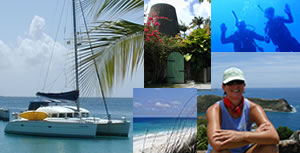


| ||||||||||||
Hawksbill Turtle Hatching You must understand that Melissa adores sea turtles. It was thus an unexpected treat that we just recently had the pleasure of witnessing Hawksbill turtle hatchlings erupt from deep within the sand in order to make their way to the sea. This is not something you get to see everyday, folks. On the southwestern shore of Bonaire, Hawksbill turtles have long established a nesting ground where eggs are laid every year. Scientists and volunteers have become skilled at observing the nesting grounds and protecting the turtle eggs and hatchlings. As part of that program, the public is invited to come and witness the final event when hatchlings boil up and out of the sand and make their way to the surf where they swim away quickly to the open sea. Along with our friends Walt and Honore on Will-O-the-Wisp, we walked to the Sea Turtle Conservation Bonaire (STCB), office where we caught a ride to the hatchling site at the southern end of the island with the STCB director, Mabel. You can visit the STCB web site at http://www.bonairenature.com/turtles/ As we arrived at the site, many spectators had already arrived. Even dolphins showed up for the event and a pod swam by close to shore as the crowd gathered. The beach area had already been marked off to keep people from walking on the underground nest (which is wholly undetectable by the untrained naked eye).
Funchi, having successfully served as "midwife" for many of these events, explained the anticipated sequence of events. First, he knew the hatchlings were ready to surface. He also knew they were about 10 inches under the sand (the length of the mother's fin). The small turtles already hatched from their eggs. If left to their own devices, they would ultimately dig to the surface, but he would give them a little help. Also, Funchi explained that once the hatchlings were ever so slightly exposed to air and light, they would become "activated" and would soon be climbing out of the nest and quickly on the move toward the sea. Finally, he explained that it is paramount that the crowd leave the fairway to the sea open and not block the light of the setting Sun -- it is the light from the setting Sun that calibrates the turtles' navigation senses, much like the Sun being the satellite to activate the turtles' GPS systems. How cool is that?!
And so, when everybody was ready, Funchi brushed away sand until just a few turtles were just barely visible -- he did not uncover them, but just brushed away enough sand to reveal that something was under the surface.
Within a few minutes, the turtles activated and in no time approximately 120 hatchlings kept coming and coming and coming out of this small but relatively deep hole. And then, it was "off to the races." Had the turtles only had numbers on their backs, a "bookie" could have made a fortune as the crowd cheered these baby turtles in their race for life. One turtle would take the lead only to fall in a rut or hole as the audience groaned and gasped. He would have to dig out while other turtles passed him by.
It took a good ten minutes for the first hatchling to reach the shore. The first wave pushed him back and left him high and dry. The turtle tried again, only to be flipped and deposited back upon the shore. The third try was the charm and he was waterborne and flipping hard. In no time, he was out of sight!
The mission: the hatchlings will swim steadily out to sea, without resting, for up to 48 hours while trying to put distance between them and the shore where thousands of predators live, both in the sky and in the sea. They will find ocean currents and travel long distances, feeding on plankton. We were told that, if lucky, probably only ONE of the hatchlings will survive by making it to an offshore patch of flotsam where the small turtle can hide and feed and grow in relative safety from predators.
| ||||||||||||||||||||
|
![]()











